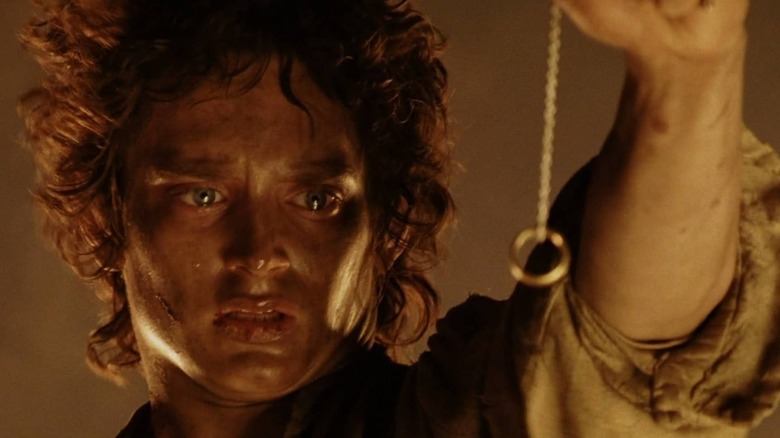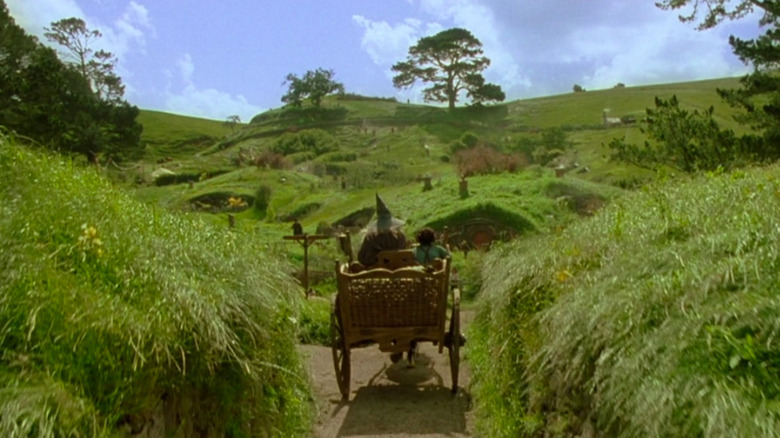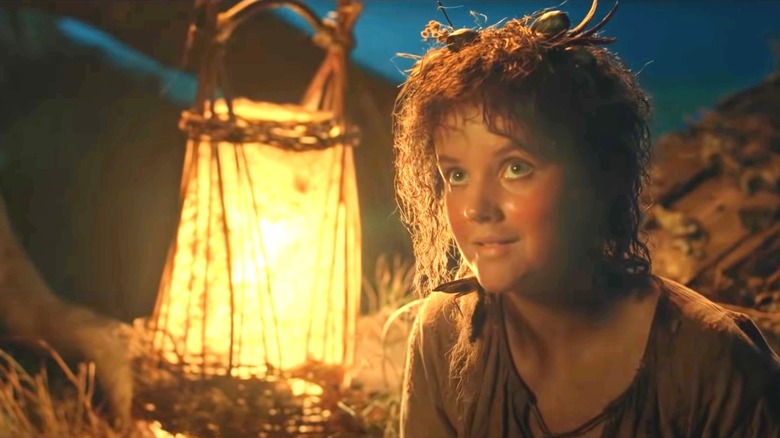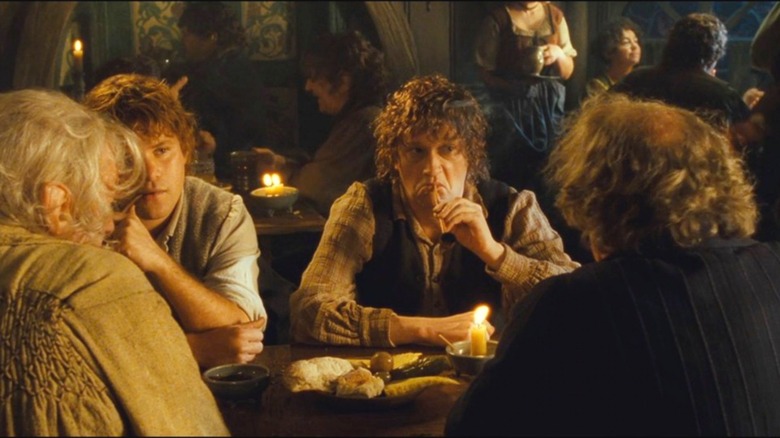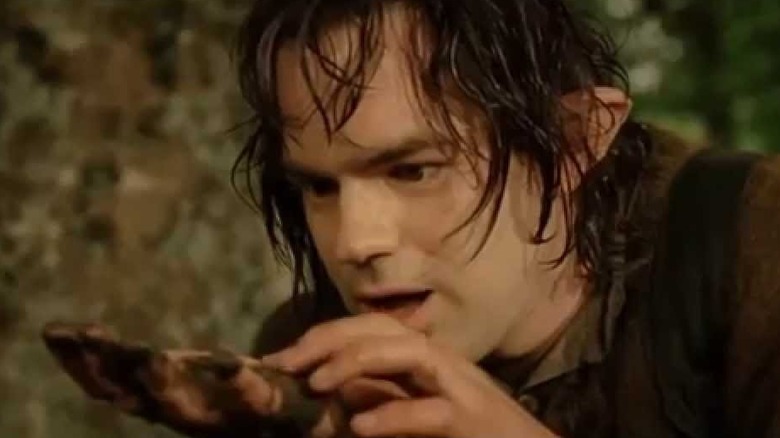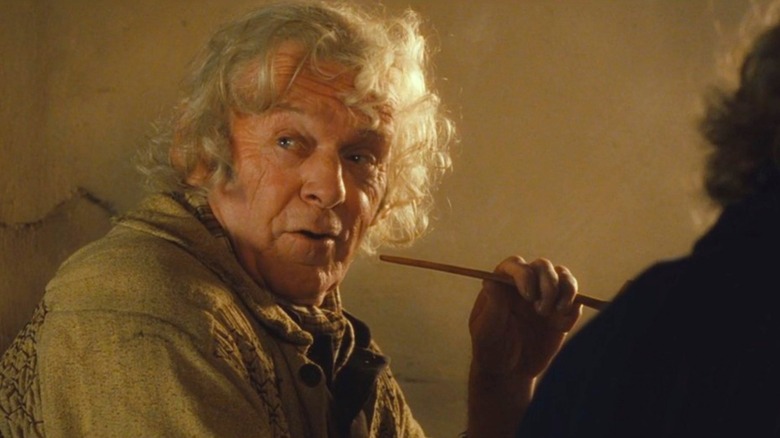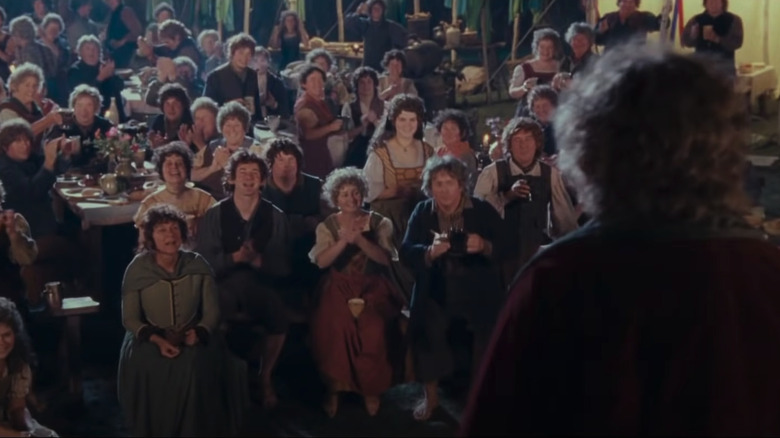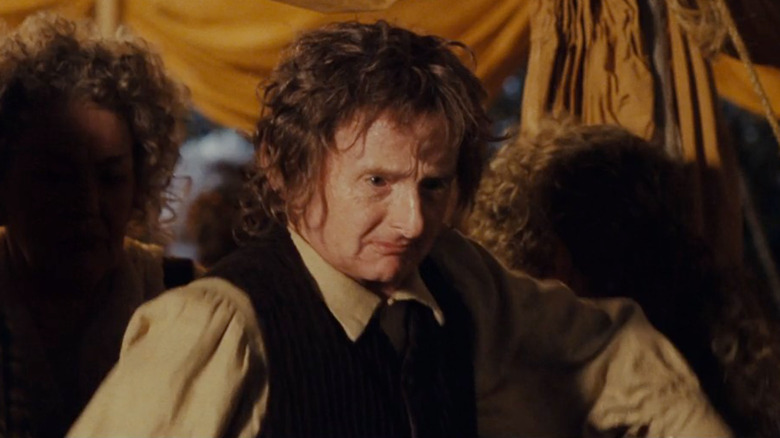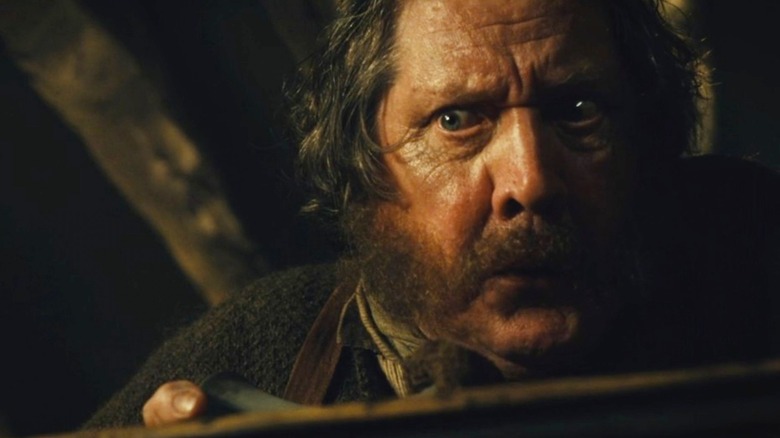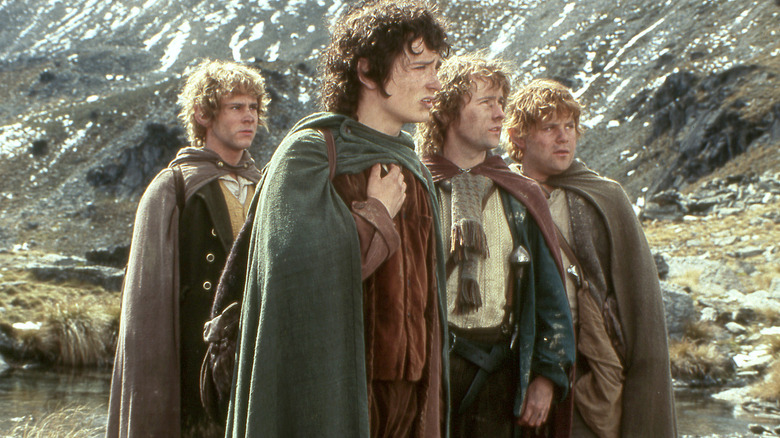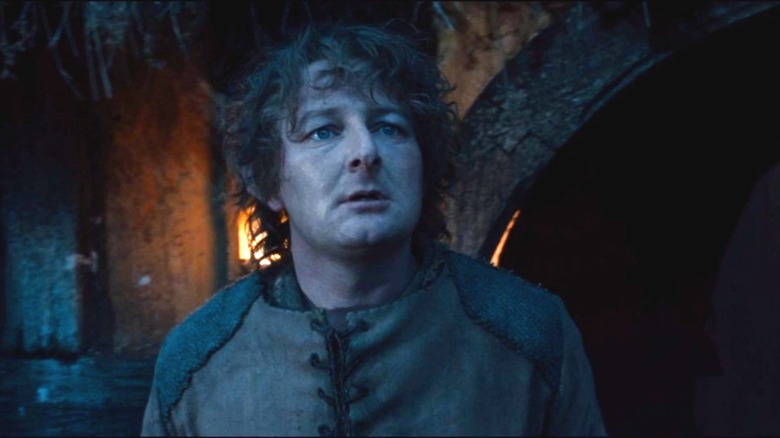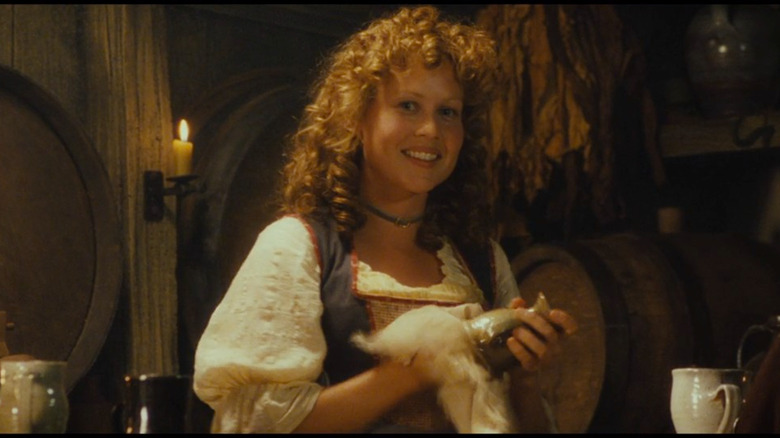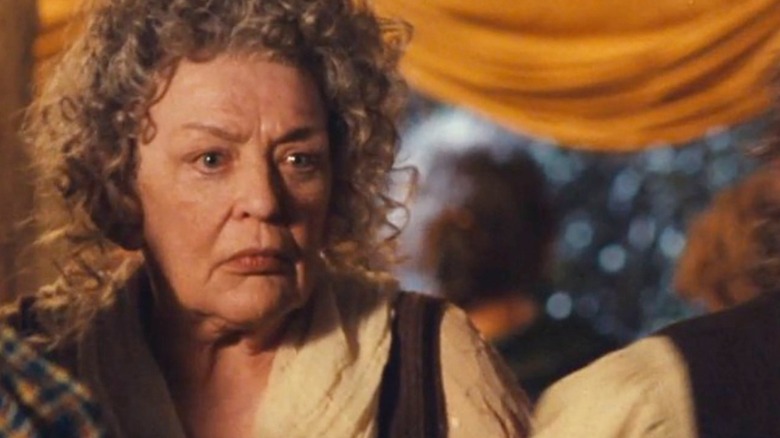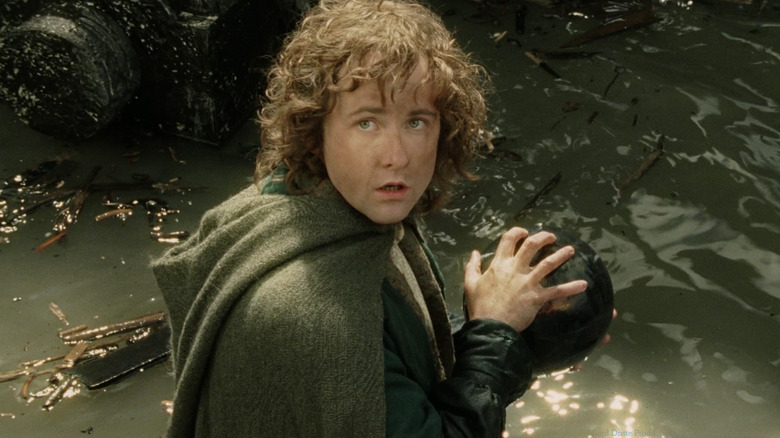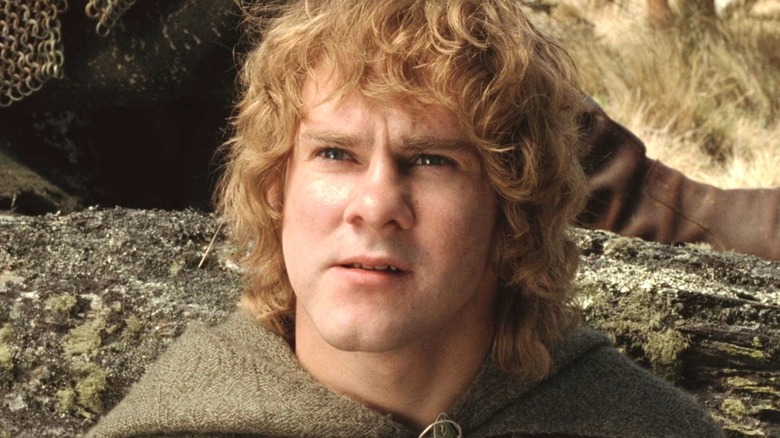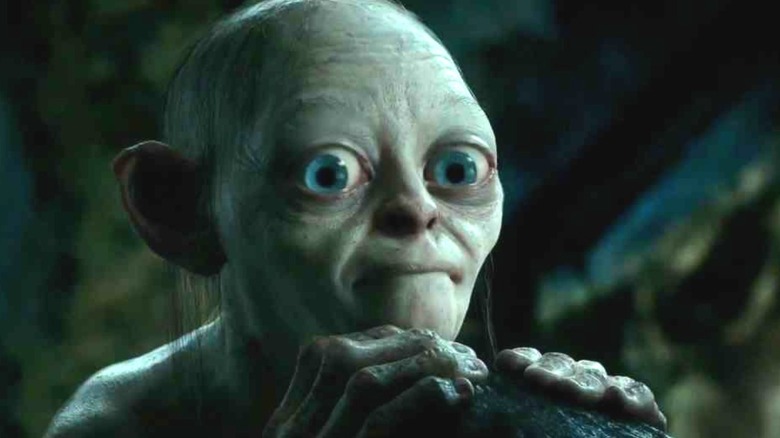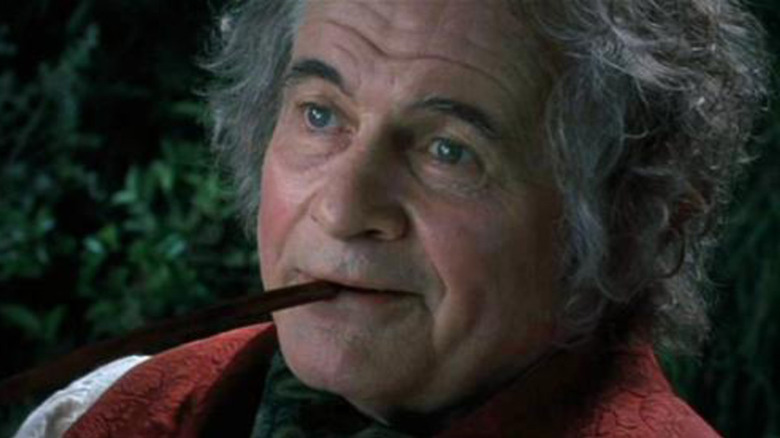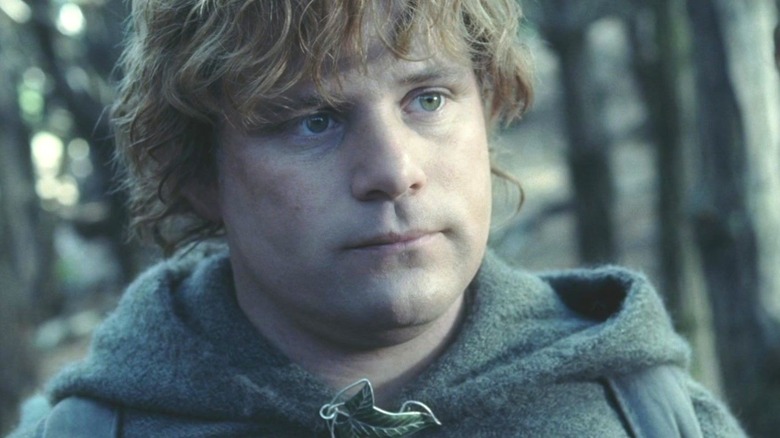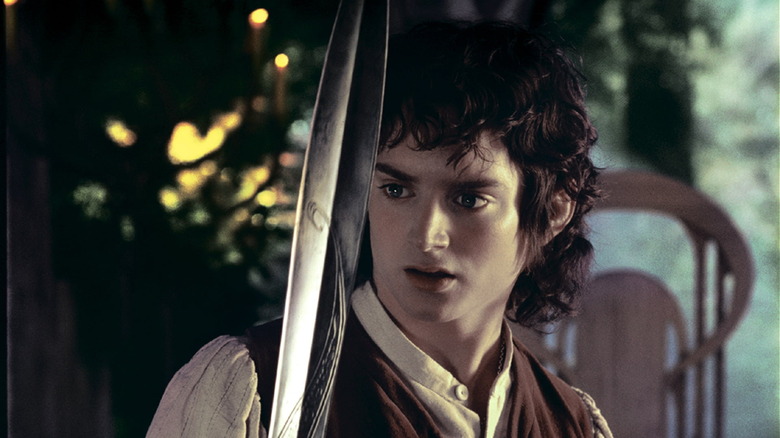All The Hobbits From Lord Of The Rings Ranked Worst To Best
Gandalf says it best: "My dear Frodo! Hobbits really are amazing creatures ... You can learn all that there is to know about their ways in a month, and yet after a hundred years they can still surprise you at a pinch." The line comes in the book "The Fellowship of the Ring," just after Frodo Baggins commits to a great quest in his little sitting room in Bag End. The ensuing adventures repeatedly put on display the hardiness and courage that the Little People possess — even if it's often hidden beneath a timid temperament and a love of all things comfortable.
This intersection of transcendent heroism and unobtrusive withdrawal isn't a coincidence. Throughout "The Lord of the Rings," Tolkien uses hobbits as a way for readers to enter the story. From the quiet fields of the Shire to the depths of Mount Doom, there is always a hobbit nearby to make things more relatable as the epic story unfolds.
There are a lot of hobbits in "Lord of the Rings." So many, in fact, that we've decided to round them all up into a good ol' worst-to-best ranking. After all, what good is this iconic race of hole-dwellers if we can't subjectively compare them to each other? Here are all of the hobbits who play at least a minor role in the story, ranked by a general conglomeration of heroics, accomplishments, humor, toughness, and overall importance to Tolkien's world.
18. Honorable Mention: Bandobras the Bullroarer
In "The Fellowship of the Ring", the titular Fellowship encounters a pack of Wargs just before they enter the Mines of Moria. There's a fight, and at one point a frightened Pippin mentions that "There is not enough of the breed of Bandobras the Bullroarer in me: these howls freeze my blood."
The character referenced by Pippin is a hero of hobbit lore: Bandobras "the Bullroarer" Took. He's famous for two reasons. First, he helped to defeat a goblin invasion of the Shire long before the events of "The Lord of the Rings.". According to "The Hobbit," Bandobras recklessly charged his enemies at the Battle of Greenfields and used a wooden club to knock the goblin king Golfimbul's head right off his shoulders. The head flew through the air and landed in a rabbit hole, winning the battle and inventing the game of golf at the same time.
The Bullroarer is also famous for his enormous size. The fellow was so huge — 4 feet 5 inches, to be precise — that he could actually ride a horse! He is surpassed in size only by Merry and Pippin, who technically cheat by drinking the size-altering Ent-draughts of Treebeard.
Bandobras is only brought up in the prologue of the first book, and his heroic acts take place long before the story. Still, he's name-dropped more than once, so he merits a mention for that reason alone.
17. Honorable Mention: Elanor Brandyfoot
Elanor "Nori" Brandyfoot is not a canon character. In fact, she isn't even technically a hobbit. She's been invented for Amazon's "Rings of Power" show and is a Harfoot — a race that is most commonly referred to as "proto-hobbits."
Nori's honorable mention status isn't because of a lack of accomplishments or personality failings — on the contrary, based on the quick glimpse that we see of the Harfoot lass in the first "Rings of Power" trailer, she seems to be quite the adventurer. However, we don't actually know anything about Nori's story so far. That's why, for now, we're giving her an "incomplete" grade. We're also considering her a representative of the Harfoots as a whole, and in a sense, of all the brave hobbit ancestors who eventually migrate to the Shire — and who are mentioned in both the prologue and the appendix to "The Lord of the Rings."
16. Ted Sandyman is a pathetic excuse for a Hobbit
The first (and worst) hobbit on the list proper is Ted Sandyman. In the movies, Sandyman only appears in one brief scene in the extended edition of "The Fellowship of the Ring." He makes fun of the stories of evil creatures surrounding the Shire and accuses Bilbo of being cracked.
While he plays a similar part in the book, Sandyman's role is a bit bigger on-page. He's in a lengthy scene in "The Fellowship of the Ring" where he verbally spars with Sam, rebutting his romantic notions of the world. Then he reappears at the end of "The Return of the King," where it's revealed that he's gone over to the dark side, helping Saruman's minions overrun the Shire and turn it into an industrialized police state. One of the major changes made to the "Return of the King" film adaptation is the removal of a sub-plot that involves the hobbits returning to the Shire, discovering that Saruman has been secretly sending the Ruffians to disrupt and subdue the peaceful land, and riling up their countrymen to defeat the invaders.
Ted Sandyman is eventually put in his place, but during his time in the story he proves to be nothing more than a troublemaking bully who runs at the first site of trouble. To the bottom of the list he goes.
15. Déagol is a Ringbearer for a second there
Poor Déagol. Everyone knows about his fate. The wretch catches a fish and is pulled overboard ... where he's caught up in the fate of the One Ring. He finds it at the bottom of the Great River and very briefly becomes a Ringbearer in the process.
While his short possession of the most powerful piece of jewelry in Middle-earth had the potential to vault him toward the top of this list, he ends up falling low on the ladder due to the fact that, moments after finding the precious bauble, Déagol is murdered for it by his friend, Sméagol.
In fact, the only reason Déagol even makes it this high s that, for a moment there, he does resist his pushy friend's demand for his newfound possession. When Sméagol requests the Ring as a birthday present, Déagol informs him that he's already gotten him an expensive gift and is going to keep the Ring. And when his treacherous friend attacks him, Déagol puts up a fight (at least on screen). He's not exactly a pushover, but he does end up playing a short, disappointing role when all's said and done.
14. The Gaffer always has an opinion
Hamfast Gamgee, better known as "the Gaffer," is Sam's dad and a staple of Tolkien's Shire-based entertainment. He makes wisecracks, puts Sam in his place, and is fiercely loyal to the Baggins family that he has served for 40 years in the respected role of family gardener.
While the Gaffer only appears briefly in "The Fellowship of the Ring" extended edition, he has a bit of a larger role in the books. Early on, we hear him sparring with Ted Sandyman's father, and when Frodo leaves the Shire, the Gaffer also has an uncomfortable conversation with a Black Rider.
In spite of his advanced age, he survives Saruman's rough treatment of the Shire, too, and is still alive and kicking when the four hobbit adventurers return. Even in the books, though, the Gaffer's role is minor, and he's little more than a piece of admittedly lovable, exposition-laced humor in most of his appearances in the story.
13. Will Whitfoot is a comedic but trusty leader
You know a character's got an interesting story when their nickname is "Flourdumpling." Will Whitfoot is the Mayor of Michel Delving, the elected leader of the Shire's capital. While the role isn't particularly important — it's really more of an honorary title — Whitfoot comes up multiple times in the books. It's Pippin who explains that the mayor is the fattest hobbit in the Westfarthing and that he received his humorous nickname when the Town Hole collapsed and he emerged from the ruin covered in chalk.
When the War of the Ring begins, things get serious in the Shire. When Saruman's Ruffians invade, basically enslaving the hobbits, Whitfoot stands up to the invaders and is the first one to be tossed into prison. He isn't released until Frodo and his companions rid the Shire of their foes. Once free, it takes a while before Whitfoot is fit to lead again, but he eventually takes up his Mayoral duties once more until being replaced by none other than Samwise Gamgee.
12. Lotho Sackville-Baggins is a corrupt but pitiable hobbit
Lotho Sackville-Baggins is a book-only character who isn't just a pretty big deal — he's also a bad guy (er, a bad hobbit). Lotho joins Saruman's lackeys when they attack the Shire and uses them to gain control over his fellow hobbits, attracting unpleasant fellows like Ted Sandyman. As far as the rest of his hobbit countrymen are concerned, Lotho uses Saruman's muscle to keep them in their place.
All that said, it's worth pointing out that Lotho isn't as bad as he looks at first glance. When Frodo talks about him toward the end of "The Return of the King, he explains that "Lotho never meant things to come to this pass. He has been a wicked fool, but he's caught now. The ruffians are on top [...] He's a prisoner in Bag End now, I expect, and very frightened."
By the time Frodo and his friends fight through Sauron's forces and reach Lotho, he's been murdered by none other than Grima Wormtongue — a miserable end to a sad character. Nevertheless, the fact that he basically rules the Shire (albeit as Saruman's puppet) during the War of the Ring bumps him at least partway up the list.
11. Nob and Bob put Bree hobbits on the map
When Frodo and his companions visit Bree in Peter Jackson's movies, it turns out to be a depressing town full of grumpy, soggy men. Oh, and Aragorn's there, too. If you read the books, though, Bree is actually a bit more upbeat — and there are hobbits that live there alongside the men.
Two of these halflings, Nob and Bob, work for Prancing Pony owner Barliman Butterbur. They don't come into the story much, but they do help Frodo and company fend off the Black Riders. Nob, in particular, shows some unexpected bravery when he tracks down Merry after the latter goes for a walk and runs into a Black Rider and one of its minions. Rather than running away, Nob shouts for help and runs up to Merry, causing the Rider and his companion to flee.
While Nob and Bob aren't heavily involved, their bravery is put on display more than once. On top of that, their rougher life outside of the Shire seems to give them an added dose of courage.
10. Fatty Bolger is the forgotten fifth hobbit
Everyone knows Frodo, Sam, Merry, and Pippin. However, only those who've read "The Fellowship of the Ring" know that there's actually a fifth member of the little hobbit posse. Fredegar "Fatty" Bolger is amongst the original group of friends who join forces with Frodo to help him reach Rivendell in safety.
The reason we don't hear about Fatty Bolger more is because he doesn't leave the Shire with Frodo. Instead, he stays behind to try to make it seem as though Frodo hasn't left yet, giving the gang more time. This tame task seems destined to drop Fatty to the bottom of this list ... that is, until he's visited by three Black Riders in search of "Shire, Bagginssss." When that happens, the hobbit has to think fast on his feet. He escapes the trap the Riders set and then sounds the alarm, forcing his enemies to flee the Shire. This brave act once again shows how quickly halflings can rally when danger threatens.
9. Farmer Maggot takes on Black Riders
Farmer Maggot is another character who barely makes the cut in Peter Jackson's films. The upstart agriculturalist is briefly shown when the Black Riders first arrive in the Shire. Maggot's dog cowers in terror at the unexpected visitors and Maggot himself looks horrified.
In the book, though, Maggot is actually a pretty impressive halfling. For one thing, he's a really important person in the Shire. His reputation is so influential that even the overpowered Tom Bombadil respects him.
For another, Maggot encounters a Black Rider in the book version of the story, too, and acquits himself significantly better. The Rider offers him gold for news of Baggins, but Maggot orders the intruder off his property, prompting the Rider to spur its horse at him before it rides off. In spite of this encounter, a few hours later Maggot generously offers shelter to Frodo and his friends and even helps them get to Bucklebury Ferry at his own peril.
8. Rosie is a steady presence
Tolkien doesn't highlight a lot of female hobbit in his books, but Rose "Rosie" Cotton is one of them. Sam's future wife (seen dancing with him in the first Peter Jackson film) is a strong-willed halfling who knows an idiot when she sees one, which is good news for Sam, because she recognizes his quiet heroics and patiently waits throughout the War of the Ring for his return.
No, really, in "The Return of the King," Rosie specifically says that she's been waiting for Sam to come back despite the Shire having been overrun and nobody believing he would ever return. Once Sam does find his way back home, the two get hitched, which means Rosie also becomes the wife of the Mayor, making her ... the First Lady of the Shire? Maybe? She also has a whopping 13 children, a heroic feat itself that would put any person high on this list.
7. Lobelia Sackville-Baggins uniquely uses her umbrella
The last female hobbit on this list is the one and only Lobelia Sackville-Baggins. For the bulk of the story, Lobelia is an antagonist. She's the power-hungry Lotho's mother, and she's constantly trying to figure out how she can hone in on Frodo's inheritance and wrestle Bag End away from Bilbo. She even steals the latter's spoons (or at least is accused of that — it's never confirmed) when Bilbo's house is being auctioned off at the end of "The Hobbit."
But then the War of the Ring starts, and when the Shire is overrun with outsiders, Lobelia's attitude starts to shift. Eventually, this leads to a tussle with the Ruffians that her own son brought into the land. In "The Return of the King," it's revealed that one day, when Lobelia goes for a walk with her trusty umbrella by her side, she comes across some Ruffians going the other way. They order her, in some unpleasant language, no less, to get out of the road. Lobelia responds by trying to hit their leader with the umbrella, which quickly gets her thrown in prison. In spite of her advanced age, however, she survives the ordeal, and when she emerges, she's cheered by the hobbits who once despised her. She gives Bag End back to Frodo and dies not long afterward.
6. Pippin is a well-rounded bundle of entertaining heroics
It doesn't take much to figure out why Peregrine Took, better know as Pippin, is so high on this list. It doesn't matter if the little guy is singing his heart out while he dances on a table, getting into troublemaking mischief with his best bud Merry, or, you know, helping to save Gondor from an invasion — wherever he goes, Pippin shows why he's one of Tolkien's best hobbit characters.
Pippin really does bring a smattering of everything to the table. He's endlessly light-hearted and regularly contributes a sense of comic relief to the story. He also bravely follows Frodo through thick and thin, survives being dragged across Rohan by orcs, helps convince the Ents to attack Isengard, and saves Faramir's life after Denethor loses his mind. In the books, Pippin even kills a troll chieftain all on his own in the battle in front of the Black Gate.
Pippin is an obvious pick for one of the best hobbits, but he doesn't do quite enough to vault him to the uppermost echelon. Those revered places are reserved for characters who have a little more impact on the actual story.
5. Merry takes on the Witch-king
Not surprisingly, Merry and Pippin appear one after another on this list. But Meriadoc Brandybuck just manages to nudge out his bestie in the rankings. Why?
Throughout the story, Merry has his head a bit straighter on his shoulders than his Tookish companion. He thinks things through more often and tends to take the lead with the whole "support Frodo however we can" campaign. On top of that, Merry is also involved in major events like the rousing of Fangorn and the Ride of the Rohirrim. But it's his actions at the Battle of the Pelennor Fields that really set him apart. He might not kill a troll, but Merry does manage to stab a Black Rider, and not just any Rider — Merry pierces the undead flesh of the Witch-king of Angmar himself. That act alone makes Merry one of the most accomplished hobbits of all time, and it puts him awfully close to the top of the list.
4. Sméagol is one impressive baddie
When Gandalf explains that Gollum is likely related to hobbits in "The Fellowship of the Ring," he says that Gollum is probably distantly related to the Stoors — one of the ancient hobbit-ish groups that existed alongside the Harfoots. This makes Gollum, in a sense, one of those "proto-hobbits."
This close connection to hobbits means we're going to include him on this list. It also means he's going to instantly rank pretty high because, you know, he keeps the One Ring for 500 years. Sure, the Ring controls him and eventually abandons him, but even that doesn't stop Gollum from showing off his abilities.
After losing the Ring, Gollum emerges from his mountain home and hunts all over Middle-earth for his "precious." He's captured by orcs and brought before Sauron, and it even takes all of Aragorn's skill to capture him and deliver him to the wood elves. During his travels with Frodo and Sam, he's shown to be very tough and fierce, especially when cornered.
Add onto all of this the simple fact that the Ring would never have been destroyed if it weren't for Gollum's part in the story, and the character nabs the highest spot for a villain.
3. Bilbo's resume is insane
There aren't too many hobbits who impact "The Lord of the Rings" as much as Bilbo. All you need to point out is that he's the one who finds the One Ring and sets the stage for the War of the Ring in the first place and you've already got a solid argument. If you add on all of Bilbo's heroics from his own adventures, the hobbit's qualifications grow exponentially. Bilbo dodges trolls, eludes goblins, outsmarts Gollum, escapes from wolves, fights off a horde of spiders, saves his friends from the wood elves' prison ... oh yeah, and he's the only person we're aware of who has a full-length conversation with the dragon Smaug and survives to tell the tale.
Add in Bilbo's humorous antics during "The Fellowship of the Ring" and the fact that he lives to be the oldest Hobbit ever — the venerable halfling reaches the age of at least 131 years old — and he easily lands in our top three.
2. Samwise Gamgee is the chief hero
Most people would put Samwise the Stouthearted near (or at) the top of this list — even Tolkien admitted that Sam was pretty much the chief hero of the whole saga. The best part of Sam's heroics, however, is that they're always provided in the form of a support role.
He starts as Frodo's gardener — and a darn good one, at that. From there, he spies on his master to make sure that Frodo is okay and ends up being pulled into the quest for the One Ring in the process. He embraces his change in fortune without skipping a beat and remains by Frodo's side throughout the rest of the journey.
Often this leads to quiet moments of heroism, such as keeping the Ringbearer fed, hydrated, and well-rested. At other times, Sam steps up in a big way. He fights off Shelob — a feat that not even men or elves could claim to have done — and carries Frodo a significant portion of the way up Mount Doom, just to name a couple of obvious achievements.
Even though Sam easily snags the second place, spot, though, we're reserving the top of the pyramid for the other hero of the story.
1. Frodo gives everything to protect Middle-earth
Frodo Baggins is one of the most unsuspecting heroes of any story, ever. He's a quiet bachelor enjoying his cushy life and inherited wealth until one day, it turns out that part of that wealth includes the One Ring. This presents Frodo with a choice: step up in a really big way, or punt on the quest and leave the heroics to someone else.
Frodo chooses to take on the immeasurable responsibility, not just once but twice. He agrees to carry the Ring to Rivendell first, then volunteers to take it on further, into the heart of Sauron's realm. While he's supported along the way by the Fellowship, Gollum, Faramir, and especially Sam, Frodo is the dude in the spotlight throughout the whole ordeal. It's up to him to keep going and to find a way to destroy the One Ring against all odds.
And that's just the obvious stuff. Tolkien also makes it clear throughout the story that Frodo is perpetually fighting an inner battle — a spiritual conflict, so to speak. It nearly consumes him multiple times, and he ultimately isn't even able to destroy the Ring without the accidental help of Gollum. Don't let that mislead you, though — it's pretty obvious by the end of the story that no one else could have done what Frodo does. In fact, he's so impacted by the experience that he ultimately leaves Middle-earth to try to find some peace in retirement away in the West.
